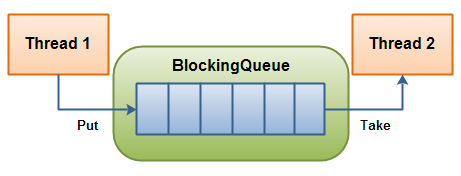BlockingQueue
来源:互联网 发布:java五子棋毕业论文 编辑:程序博客网 时间:2024/06/11 03:29
BlockingQueue
The Java BlockingQueue interface in the java.util.concurrent package represents a queue which is thread safe to put into, and take instances from. In this text I will show you how to use this BlockingQueue.
This text will not discuss how to implement a BlockingQueue in Java yourself. If you are interested in that, I have a text on Blocking Queues in my more theoretical Java Concurrency Tutorial.
BlockingQueue Usage
A BlockingQueue is typically used to have on thread produce objects, which another thread consumes. Here is a diagram that illustrates this principle:
 A BlockingQueue with one thread putting into it, and another thread taking from it.
A BlockingQueue with one thread putting into it, and another thread taking from it.The producing thread will keep producing new objects and insert them into the queue, until the queue reaches some upper bound on what it can contain. It's limit, in other words. If the blocking queue reaches its upper limit, the producing thread is blocked while trying to insert the new object. It remains blocked until a consuming thread takes an object out of the queue.
The consuming thread keeps taking objects out of the blocking queue, and processes them. If the consuming thread tries to take an object out of an empty queue, the consuming thread is blocked until a producing thread puts an object into the queue.
BlockingQueue Methods
A BlockingQueue has 4 different sets of methods for inserting, removing and examining the elements in the queue. Each set of methods behaves differently in case the requested operation cannot be carried out immediately. Here is a table of the methods:
add(o)offer(o)put(o)offer(o, timeout, timeunit)Removeremove(o)poll()take()poll(timeout, timeunit)Examineelement()peek() The 4 different sets of behaviour means this:
- Throws Exception:
If the attempted operation is not possible immediately, an exception is thrown. - Special Value:
If the attempted operation is not possible immediately, a special value is returned (often true / false). - Blocks:
If the attempted operation is not possible immedidately, the method call blocks until it is. - Times Out:
If the attempted operation is not possible immedidately, the method call blocks until it is, but waits no longer than the given timeout. Returns a special value telling whether the operation succeeded or not (typically true / false).
It is not possible to insert null into a BlockingQueue. If you try to insert null, the BlockingQueue will throw a NullPointerException.
It is also possible to access all the elements inside a BlockingQueue, and not just the elements at the start and end. For instance, say you have queued an object for processing, but your application decides to cancel it. You can then call e.g. remove(o) to remove a specific object in the queue. However, this is not done very efficiently, so you should not use these Collection methods unless you really have to.
BlockingQueue Implementations
Since BlockingQueue is an interface, you need to use one of its implementations to use it. Thejava.util.concurrent package has the following implementations of the BlockingQueue interface (in Java 6):
- ArrayBlockingQueue
- DelayQueue
- LinkedBlockingQueue
- PriorityBlockingQueue
- SynchronousQueue
Click the links in the list to read more about each implementation. If a link cannot be clicked, that implementation has not yet been described. Check back again in the future, or check out the JavaDoc's for more detail.
Java BlockingQueue Example
Here is a Java BlockingQueue example. The example uses the ArrayBlockingQueue implementation of the BlockingQueue interface.
First, the BlockingQueueExample class which starts a Producer and a Consumer in separate threads. TheProducer inserts strings into a shared BlockingQueue, and the Consumer takes them out.
public class BlockingQueueExample { public static void main(String[] args) throws Exception { BlockingQueue queue = new ArrayBlockingQueue(1024); Producer producer = new Producer(queue); Consumer consumer = new Consumer(queue); new Thread(producer).start(); new Thread(consumer).start(); Thread.sleep(4000); }}Here is the Producer class. Notice how it sleeps a second between each put() call. This will cause theConsumer to block, while waiting for objects in the queue.
public class Producer implements Runnable{ protected BlockingQueue queue = null; public Producer(BlockingQueue queue) { this.queue = queue; } public void run() { try { queue.put("1"); Thread.sleep(1000); queue.put("2"); Thread.sleep(1000); queue.put("3"); } catch (InterruptedException e) { e.printStackTrace(); } }}Here is the Consumer class. It just takes out the objects from the queue, and prints them to System.out.
public class Consumer implements Runnable{ protected BlockingQueue queue = null; public Consumer(BlockingQueue queue) { this.queue = queue; } public void run() { try { System.out.println(queue.take()); System.out.println(queue.take()); System.out.println(queue.take()); } catch (InterruptedException e) { e.printStackTrace(); } }}- BlockingQueue
- BlockingQueue
- BlockingQueue
- BlockingQueue
- BlockingQueue
- BlockingQueue
- BlockingQueue
- BlockingQueue
- BlockingQueue
- BlockingQueue
- BlockingQueue
- BlockingQueue
- BlockingQueue
- BlockingQueue
- BlockingQueue
- BlockingQueue
- BlockingQueue
- BlockingQueue
- 二叉树遍历 前中后
- iOS 沙盒存储 读取图片
- 工具篇:Mantle
- 每日一vim(10)正则表达式
- 《从零开始学Swift》学习笔记(Day 53)——do-try-catch错误处理模式
- BlockingQueue
- 熊猫酷跑游戏源码项目
- springmvc+spring+mybatis集成问题汇总
- 文件管理类NSFileManager常用操作
- Java深入(高新技术)(五):注解
- Winform DataGridView添加进度条
- Chrome扩展及应用开发 入门笔记(六)进阶(网络请求,脚本注入)
- [LeetCode 313] Super Ugly Number
- Hibernate基础(一)——连接数据库,并导出表


